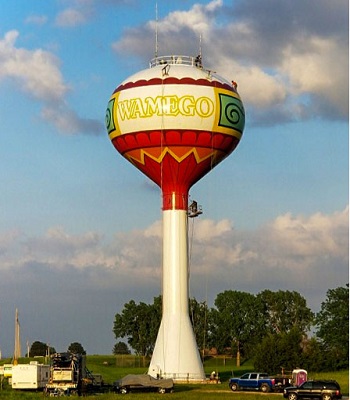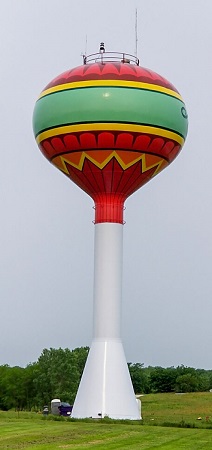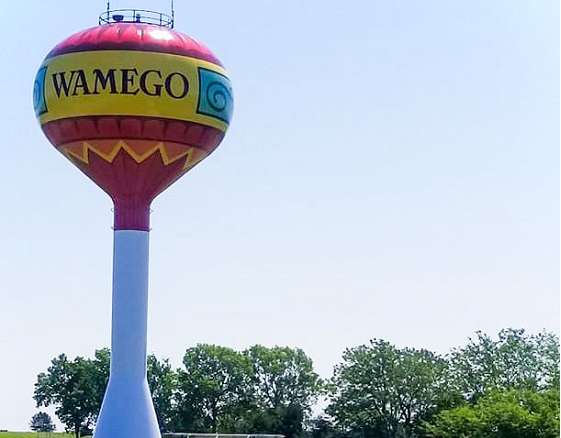Since 2003, Wamego, Kan., has been home to the Oz Museum, showcasing the largest permanent public display of “Wizard of Oz” books and movie artifacts in the world. Now the small Midwest town of about 5,000 people is also home to an award-winning, elevated steel water tank.
Upon entering the town, visitors will notice the 500,000-gallon (~1.9 million L) single-pedestal tower as a hot air balloon decorated with bright colors. “The colors and design reflect the city’s bright atmosphere, the Oz Museum, and the fun festivals that are held each year in Wamego,” states the website for BG Consultants, whose engineering team was involved with the project from the start.
Erected by Chicago Bridge & Iron in 2010, the spherical elevated tank was given a finish coat of white Tnemec Series 700 Hydroflon at the time. In 2015, the city of Wamego tried to put together the funding to decorate the tower as a hot air balloon, complete with a basket holding characters from the Oz tale. But the project never got off the ground — excuse the pun.
Getting to Kansas
Finally, in 2019, when BG Consultants and the city of Wamego rebid the project once again, the winning bid came from Classic Protective Coatings out of Menomonie, Wisc. Classic has been in business since 1996, and the company now has approximately 50 employees who work to rehabilitate water tanks nationwide.
Brad Smith, senior project manager at Classic, sent five crew members to paint the decorative design on the tower in Wamego. “We brought at least one 52-foot [16 m] equipment trailer down there,” said Smith while describing the mobilization of the crew. “We had some smaller stuff on a 25-foot [8 m] trailer with air compressor and washers, diesel-powered equipment that we brought to the site.”
Because the steel tank was only nine years old at the time, the interior was not touched on this project, although it was drained of its potable water so that the crew could access the exterior.
Smith describes the process of accessing the exterior of the steel tank: “We use air-powered scaffold,” he said. “They climb up the inside of the tank with ladders with safety climbs, up to the roof, tie off, and then they secure their cables and safety ropes off the side of the tank. Then they go up and down daily with the same air-powered equipment.”
Personal protective equipment worn by the crew while accessing the tank included 3M DBI-SALA safety harnesses, lanyards, and trauma straps (the latter installed as an extra safety precaution). They also wore hard hats, safety glasses, steel-toed boots, 3M 6000 Series half-mask respirators, 3M 6001 organic vapor cartridges, and 33-db hearing protection as needed.
Prepping for Oz
 With safe access to the tank in place, Classic’s crew could now begin surface preparation. They removed all visible oil, grease, dirt, and other soluble contaminants to a Society for Protective Coatings (SSPC) SP1, “Solvent Cleaning” standard. Because the tank had that nine-year-old finish coat on it, only minor areas needed touchups.
With safe access to the tank in place, Classic’s crew could now begin surface preparation. They removed all visible oil, grease, dirt, and other soluble contaminants to a Society for Protective Coatings (SSPC) SP1, “Solvent Cleaning” standard. Because the tank had that nine-year-old finish coat on it, only minor areas needed touchups.
“Preparation was pressure wash and sand as needed,” Smith said, “because there were areas of gloss that you had to prep properly to get a surface that was suitable for the overcoat. Then there were areas of corrosion we touched up and ground down and primed prior to the finish coat applications — very minor.”
Classic’s crew used two hydraulic pressure washers capable of more than 4,000 psi (27.6 MPa) for the pressure washing step. “We just hooked up a garden hose to the pump on that and ran the pressure washers,” Smith said. “I think they had two washers out there for two guns, and I think three or four of them did it. You know, some people are moving rigging as they go around. There’s people on the roof, people on the ground moving rigging as they run around the tank.” Potable water was used, so the crew did not have to collect any of the spent water.
The crew also performed hand sanding as needed to de-gloss the surface.
Yellow Brick Steel Road
Spot priming and an intermediate coat were then applied to get the steel tank ready for the mural. “The primer coat was 91-H20, and the intermediate of Series 1075 urethane, and then a finish coat of the 700 Hydroflon,” said Smith, referring to the coatings system of Tnemec’s Series 91-H20 Hydro Zinc zinc-rich primer, Series 1075 Endura-Shield II aliphatic acrylic polyurethane, and the finish coat product that had previously been used on the tank.
While applying the coating system, the crew used the same air-powered scaffold, per Smith. “We used brush and roll for a lot of it. We had to go up and mark out the logo with a pattern. Tank Logos LLC provided us a pattern. Then they basically just use a big black magic marker and put all these dots on the tank that they later on have to connect the dots to lay it out.”
After that, it was simply a matter of applying the mural colors. “We based the bid off the design that they requested,” Smith said. “Originally…they had wanted a similar design with a hot air balloon basket under it. But this year they got rid of the hot air balloon basket with people in it.”
Eight colors of the Series 700 HydroFlon fluoropolymer coating system were applied using 9-inch (22.9 cm) rollers with 1/4- to 3/8-inch (6.4–9.5 mm) naps. Those eight colors were warbird (a medium gray), spearmint, hunter green, lemon yellow, tangerine orange/safety, candy apple red/safety, artic rain (a light gray), and black.
The goal for each coat was 3–4 mils (76.2 –101.6 microns) dry film thickness, and the finish coat was intended to be done in one pass. However, according to Smith, “in some areas, a lot of it was done in a two-coat application due to the depth, the deep color change from a white to a color — took a couple coat application.”
As a result, “it was color and mil thickness together,” Smith explained. “Sometimes you can’t get it in the 2 to 3 mils [50.8–76.2 microns]. You have to put on 3 to 4. This stuff is 60-percent volume solids, so you have an application loss from solvents.”
 There were also areas where only one color could be applied at a time. “If there’s a wet-edge coating that met up to another wet-edge coating, it was only one color at a time,” said Smith. “But there were times when there was separation between colors, where they could be up in an area that had different colors. But they didn’t mix the paint too much ahead of time because you’ve got an application time of your coating. They were trying to monitor that as we were mixing paint for it.”
There were also areas where only one color could be applied at a time. “If there’s a wet-edge coating that met up to another wet-edge coating, it was only one color at a time,” said Smith. “But there were times when there was separation between colors, where they could be up in an area that had different colors. But they didn’t mix the paint too much ahead of time because you’ve got an application time of your coating. They were trying to monitor that as we were mixing paint for it.”
A Winner All Around
In all, the Wamego water tower project spanned 29 days, ending in June 2019. The main challenge was an unseasonably wet spring. According to Heather Bauer, the company’s industrial health and safety manager, “Classic Protective Coatings encountered rain days where we were unable to have our crews work and had to shut down production. However, our experience and thoroughly trained crew members increased productivity and put in extra hours on good weather days to make up time.”
“There were days when you couldn’t plan every day,” added Smith. “It wasn’t like seven days a week or six days a week they could work. There were probably three days here and two days here, ’cause there was a lot of rain in between.”
Bauer pointed out, “This project was completed with zero injuries. Classic Protective Coatings takes great pride in providing our employees with a safe and healthy work environment to all employees. Employees are…required to undergo annual safety training. Also, we did everything — 100 percent — with our own crews, our own equipment, our own mobilization, without outsourcing.”
Despite the rainy weather, Classic’s crew turned out an award-winning project. Tnemec has been conducting “Tank of the Year” awards since 2006, and as Bauer explained, “This is the first time that both the People’s Choice Award and Tank of the Year have gone to the same contractor.” Now visitors to and residents of Wamego can enjoy even more Oz!
This article was originally published in the spring 2020 edition of WaterCorr News. Reprinted with permission.
